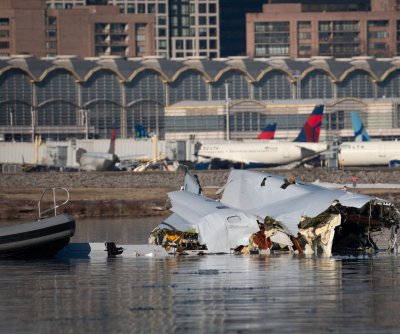1 of 2 | Response boat crews from the U.S. Coast Guard enforce a safety zone around the incident scene in the Potomac River on January 30. An American Airlines plane and a U.S. Army helicopter collided and crashed into the Potomac River. Photo by Class Brandon Giles/U.S. Coast Guard | License Photo
Feb. 14 (UPI) — The U.S. Army Black Hawk crew possibly didn’t know there was an impending collision with a American Airlines jet in Washington, D.C., that resulted in the most deadly crash in the United States in 23 years, National Transportation Safety Board Chairman Jennifer Homendy said Friday.
This included bad information on the altitude from the altimeter and missed information from air traffic control, she said at a news conference in Washington.
“We are looking at the possibility of there may be bad data” Homendy said. “We have a lot of work to do till we get to that.”
NTSB has analyzing flight data and voice transmissions from the black boxes.
There was a discrepancy in the altitude of the Sikorsky UH-60. At 8:43 p.m. ET, the pilot flying indicated they were at about 300 feet, but an instructor pilot indicated they were at about 400 feet.
“Neither pilot made a comment discussing an altitude discrepancy,” she said. “At this time, we don’t know why there was a discrepancy between the two. That’s something the investigative team is analyzing.”
Also, the crew might not have heard a transmission from the tower that instructed them to go behind the plane because it was at 1,200 feet and circling just south of the Woodrow Wilson Memorial Bridge.
Seconds before the crash, the tower had asked the Black Hawk whether it had the airplane in sight and advised it to directly pass behind the jet, audio from the tower shows.
The pilot may have keyed her radio at the same second and stepped on the transmission from air traffic control, the NTSB added.
And the Black Hawk crew members were likely wearing night vision goggles throughout the flight, which would affect their vision.
It is like “looking through soda straws,” said Dean Winslow, a retired Air Force colonel not involved in the investigation, told NBC News.
Pilots were required to wear those goggles as part of an annual training flight.
Capt. Rebecca Lobach, an aviation officer since 2019 with about 500 flying hours, was undergoing the night portion of the exam.
American Eagle Flight No. 5342 was preparing to land at Ronald Reagan Washington National Airport when it collided with the Black Hawk. Both aircraft plunged into the Potomac River at 8:47 p.m. with no survivors among the 64 aboard the jet and three in the helicopter.
The Black Hawk was equipped with an advanced surveillance technology that helps the aircraft share more accurate data with air traffic controllers, known as an Automatic Dependent Surveillance-Broadcast, or ADS-B. Homendy said NTSB could not say whether it was turned off.
“A lot of people are asking about was it turned off, there are other things we have to rule out first,” she said.
Homendy praised Transportation Secretary Sean Duffy for restricting helicopter traffic around Reagan airport after the crash.





